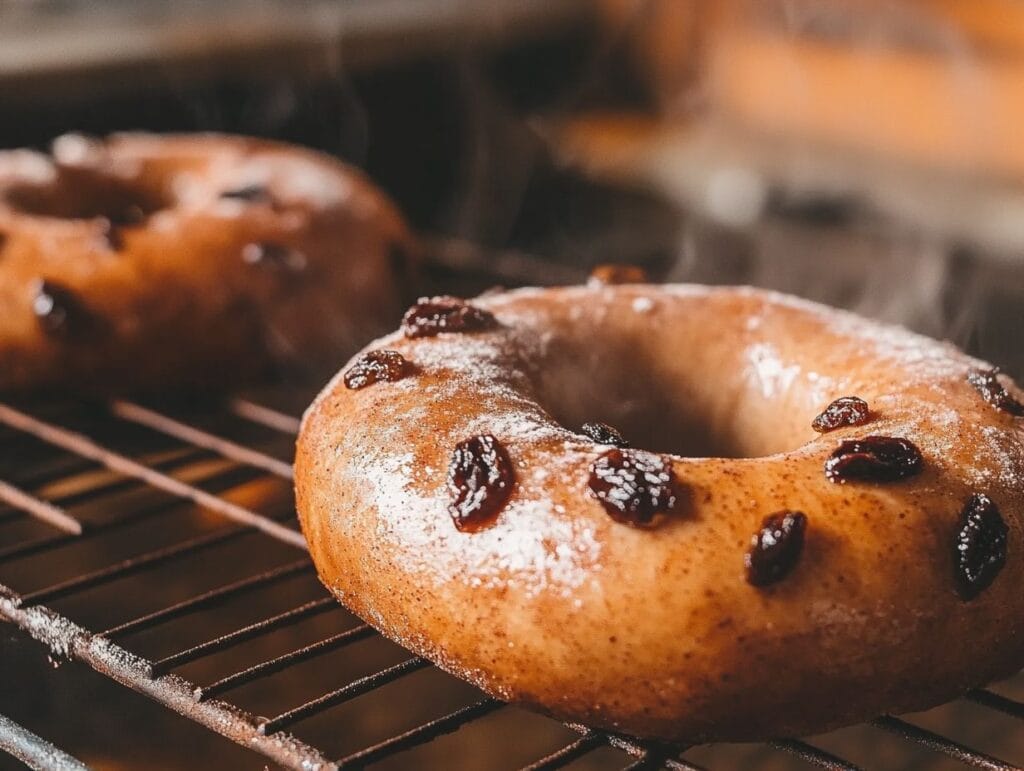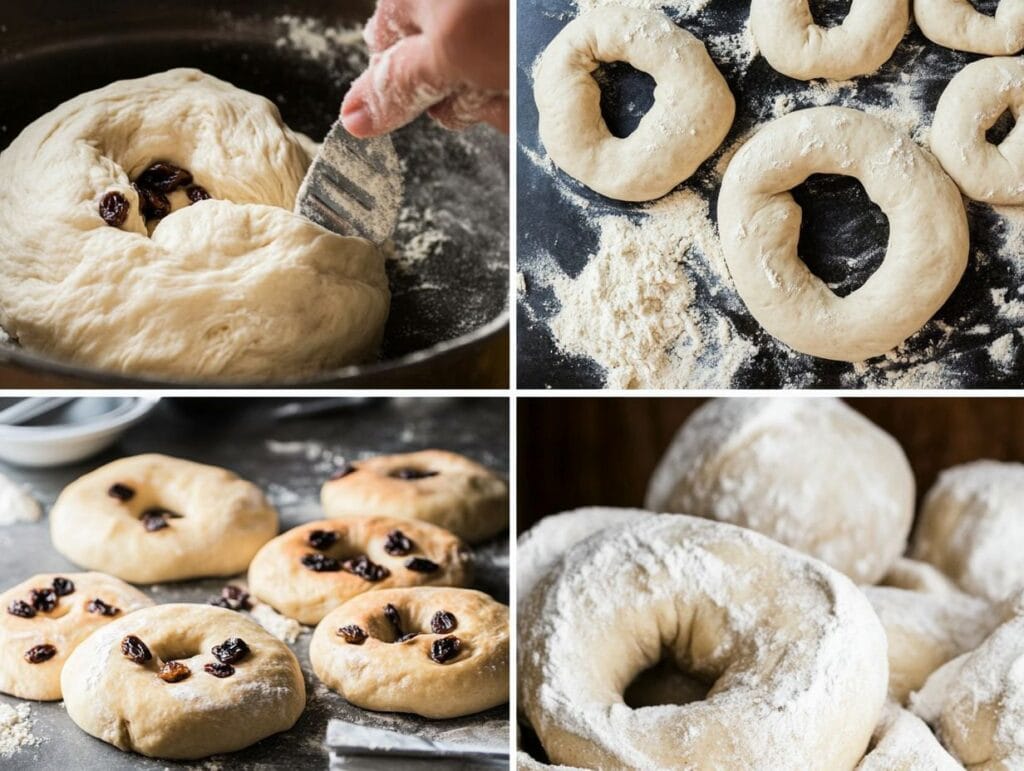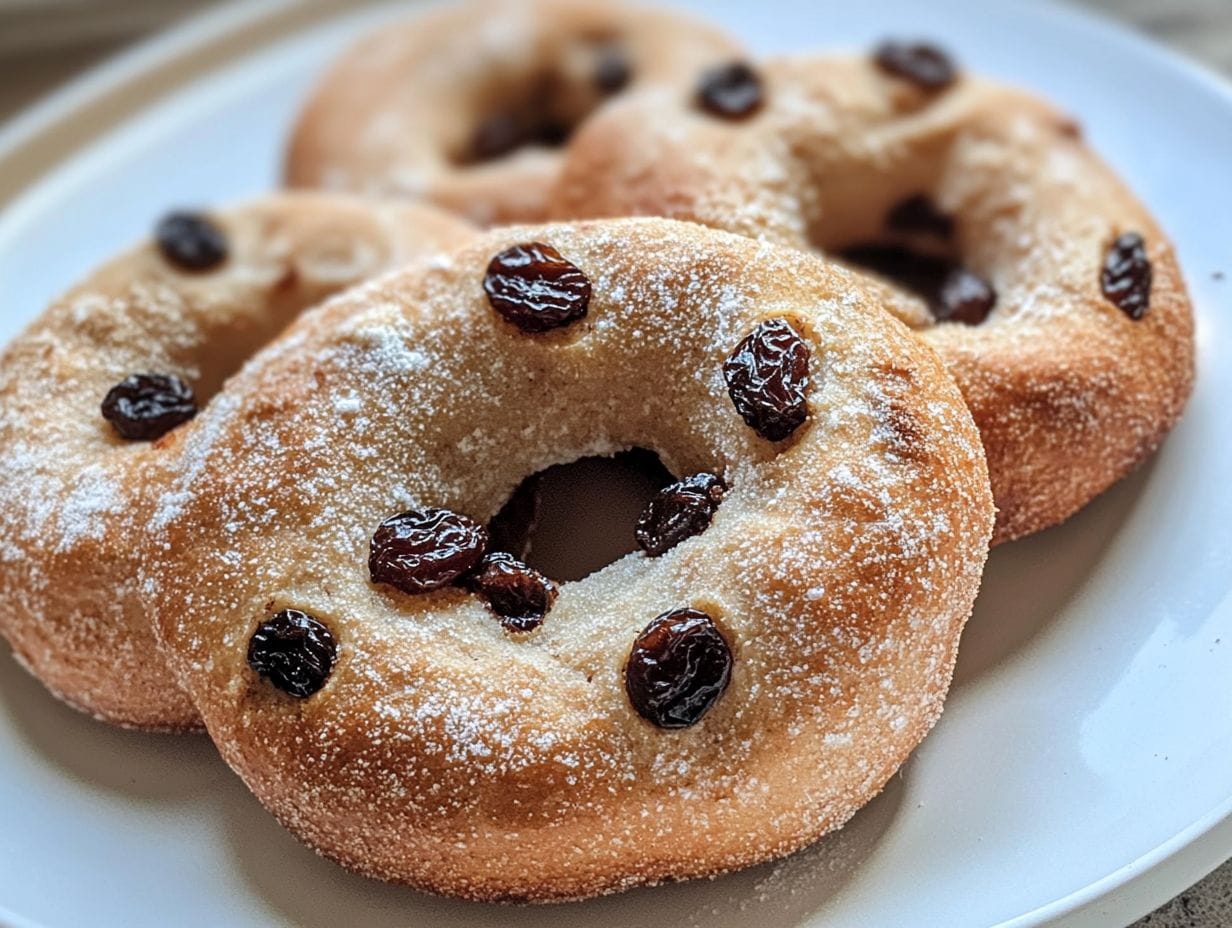Last updated on: December 17, 2024
Introduction
Who can resist the warm, comforting aroma of freshly baked cinnamon raisin bagel wafting through the kitchen? Not only are these delightful treats a staple at many breakfast tables, but they also offer a satisfying challenge to home bakers looking to hone their skills. In this guide, we’ll walk through the process of making cinnamon raisin bagels from scratch, ensuring you can recreate that bakery-fresh taste in your kitchen.
What Makes Cinnamon Raisin Bagel Special?
Cinnamon raisin bagels are a unique blend of sweet and spicy flavors paired with a dense, chewy texture. The addition of cinnamon and raisins offers a perfect balance of sweetness and spice, making these bagels a beloved choice for breakfast or snack time.
Looking for other comforting breakfast ideas? Check out our guide to making the perfect cinnamon roll French toast for another sweet and satisfying morning treat.
Quote: “Cinnamon raisin bagels are not just a breakfast food; they’re a comforting treat that can be enjoyed at any time of day.”
Why Make Your Own Bagels at Home?
Making bagels at home lets you control the quality of the ingredients and create customizable variations. The process might seem daunting, but it’s deeply rewarding and ensures a fresher, healthier alternative to store-bought options.
For a dive into homemade breakfast recipes, explore our mini pancake breakfast guide to discover another delightful way to start your day.

Ingredients Needed
Before diving into the baking process, let’s ensure you have all the necessary ingredients on hand. For cinnamon raisin bagel, you’ll need:
- High-gluten flour: This gives the bagels their classic chewy texture.
- Warm water: Acts as the base of the yeast mixture.
- Yeast: Preferably active dry yeast to help the dough rise.
- Sugar: To feed the yeast and add a touch of sweetness.
- Salt: Enhances the flavor.
- Cinnamon: For that spicy flavor profile.
- Raisins: Choose plump and juicy varieties for the best texture.
Curious about ingredient alternatives for other dishes? Don’t miss our tips on avoiding a soggy cottage cheese flatbread for a perfectly textured base.
Essential Ingredients for Bagel Dough
The dough is the foundation of any great bagel. Using high-gluten flour is crucial because it creates a denser and chewier bagel, which is the hallmark of this breakfast favorite.
Tip: “Always check the expiration date on your yeast, as old yeast can lead to dough that doesn’t rise properly.”
Choosing the Best Raises and Cinnamon
The quality of the raisins and cinnamon can make or break your bagel. Look for dark, plump raisins that have a natural sweetness, and avoid those that look dry or shriveled. As for cinnamon, the fresher, the better. Freshly ground cinnamon will provide a more potent flavor than pre-ground options.
Equipment Required
To make bagels, you’ll need a few basic but essential tools:
- Mixing bowls: For preparing the dough.
- Dough hook: If you’re using a stand mixer.
- Baking sheets: Preferably lined with parchment paper.
- Large pot: For boiling the bagels before baking.
- Slotted spoon: Helps remove the bagels from the boiling water.
Kitchen Tools for Bagel Making
While specialized equipment like a dough mixer can make the process easier, it’s perfectly possible to make bagels using just a few basic kitchen tools. A sturdy mixing bowl and a wooden spoon can do the job just as well, though a bit more elbow grease may be required.
Substitutes for Specialized Tools
If you don’t have a dough hook or a stand mixer, don’t worry. A sturdy wooden spoon and a bit of extra time and effort kneading by hand can yield equally good results. Remember, the key to great bagel dough is thorough mixing and kneading, regardless of the tools used.
This segment introduces you to the art of making cinnamon raisin bagels, detailing the ingredients and tools required. In the next part, we’ll delve into the step-by-step process of creating the dough, proofing, shaping, and boiling your bagels to achieve that perfect texture and flavor. Stay tuned, and get ready to bake!
Step-by-Step Guide to Making Cinnamon Raisin Bagel
Making cinnamon raisin bagels at home is a rewarding process that involves several key steps: preparing the dough, proofing, shaping, and finally, boiling and baking. Each step is crucial in achieving the perfect bagel.

Preparing the Dough
The first step in making bagels is preparing the dough. It’s a process that sets the foundation for the texture and flavor of your bagels.
- Activate the Yeast: In a small bowl, dissolve a teaspoon of sugar into the warm water. Sprinkle the yeast over the water and let it sit for about 5 minutes until it becomes foamy. This step is vital as it ensures your yeast is active and ready to help your dough rise.
- Mix Dry Ingredients: In a large bowl, whisk together the high-gluten flour, cinnamon, and salt.
- Combine Wet and Dry Ingredients: Add the yeast mixture and a tablespoon of vegetable oil to the dry ingredients. Mix until a sticky dough begins to form.
- Add Raisins: Fold in the raisins evenly to distribute them throughout the dough.
- Knead the Dough: Turn the dough out onto a floured surface and knead for about 10 minutes. The dough should be elastic and smooth. If it’s too sticky, add a bit more flour, but be careful not to make it too dry.
Check out why restaurant pancakes are so fluffy to understand more about achieving perfect textures in baked goods.
Tip: “Kneading is key in gluten development which gives bagels their chewy texture. Don’t rush this step!”
The Importance of Proofing
Proofing, or allowing the dough to rise, is crucial for developing the flavors and texture of the bagels.
- First Proof: Once kneaded, place the dough in a lightly oiled bowl and cover it with a damp cloth. Let it rise in a warm, draft-free area for about 1 hour, or until it doubles in size.
- Punch Down the Dough: After the first rise, punch down the dough to release any air bubbles. This step helps in creating a uniform texture in the bagels.
Shaping Your Bagels
Shaping bagels is fun and allows for some creativity.
- Divide the Dough: Turn the risen dough onto a lightly floured surface and divide it into 12 equal pieces.
- Form the Bagels: Roll each piece into a ball. Press your thumb through the center of each ball to form a hole, and then stretch the dough slightly to shape it into a classic bagel shape. The hole should be about 1/3 the diameter of the bagel.
Enhance your skills with insights from our perfect French toast tips to discover common mistakes and solutions in breakfast classics.
Quote: “The bagel’s shape is iconic, and getting it just right can be a satisfying challenge.”
Boiling the Bagels: Why It’s Crucial
Boiling bagels before baking is what gives them their distinctive chewy crust and slightly dense texture.
- Prepare the Boiling Solution: In a large pot, bring water to a boil. Add a tablespoon of sugar to help the bagels brown during baking.
- Boil the Bagels: Place a few bagels at a time into the boiling water. Let them boil for about 1 minute on each side. This process also helps the bagels expand and develop a shiny crust.
- Drain and Prepare for Baking: Use a slotted spoon to remove the bagels from the water and place them on a baking sheet lined with parchment paper.
In the next part, we will cover the baking process, how to achieve the perfect crust, and common problems and their solutions to ensure your bagels turn out perfectly every time. Stay tuned for more tips and tricks!
Baking Techniques and Tips
After boiling, the next crucial step is baking your bagels to perfection. This section will guide you through the baking process and offer tips to achieve the best results.
Achieving the Perfect Crust
The secret to a great bagel crust lies in the baking technique.
- Preheat Your Oven: Ensure your oven is preheated to 425°F (220°C). Consistent, high heat is crucial for baking bagels that are crispy on the outside and soft on the inside.
- Egg Wash: For an extra shine and a golden-brown crust, brush each bagel lightly with an egg wash (a beaten egg mixed with a little water) before baking.
- Baking Time: Bake the bagels for about 20-25 minutes or until they are golden brown. Rotate the baking sheet halfway through the baking time to ensure even browning.
If you enjoy experimenting, try incorporating tips from our best mini pancake recipes to add creative twists to your baking repertoire.
Tip: “Always keep an eye on your bagels as oven temperatures can vary. The perfect color is a deep golden brown, not pale or dark brown.”
Baking Temperatures and Times
Getting the temperature and timing right is crucial for the texture you desire.
- For a chewier crust: Bake at a slightly higher temperature for a shorter time.
- For a softer crust: Lower the oven temperature and bake for a longer period.
Common Problems and Solutions
Even experienced bakers can run into issues when making bagels. Here are some common problems and their solutions.
Dough Too Sticky or Too Dry
Problem: The dough is too sticky to handle or too dry and tough.
Solution: If the dough is too sticky, gradually add flour, a tablespoon at a time, until it reaches the right consistency. If it’s too dry, add water by the teaspoon until it becomes manageable.
Bagels Aren’t Fluffy Enough
Problem: Bagels come out dense and not as fluffy as expected.
Solution: Ensure your yeast is fresh and active, and allow sufficient proofing time. Over-kneading can also cause dense bagels, so be mindful during the kneading process.
Quote: “Patience is key in baking. Rushing the proofing process can result in less than perfect bagels.”
Issues with Boiling and Baking
Problem: Bagels deflate after boiling or don’t brown well in the oven.
Solution: Make sure the water is at a rolling boil before adding the bagels, and don’t overcrowd the pot. For browning issues, ensure the use of an egg wash and check that your oven is properly calibrated.
Serving and Storing Your Bagels
Now that you’ve mastered the art of bagel making, let’s talk about the best ways to serve and store them.

Best Practices for Serving
Freshly baked bagels are best served warm. They pair wonderfully with cream cheese, butter, or your favorite bagel toppings. For a delightful breakfast, try serving them with a side of fresh fruit or yogurt.
How to Store and Reheat Bagels
To keep your bagels fresh, store them in a bread box or wrap them in a cloth inside a plastic bag at room temperature for up to 2 days. For longer storage, slice and freeze them in airtight bags.
- Reheating: To revive a bagel to its former glory, toast it or reheat it in the oven at 375°F (190°C) for about 5-8 minutes.
FAQ
Are Cinnamon Raisin Bagels healthy?
Cinnamon raisin bagels can be a part of a healthy diet when consumed in moderation. They provide energy primarily through carbohydrates and small amounts of protein. Incorporating whole grains and reducing sugar can enhance their nutritional profile, making them healthier. As with all foods, the key is balance and portion control.
What goes well on a cinnamon raisin bagel?
Cinnamon raisin bagels are versatile and can be enjoyed with a variety of toppings. Cream cheese is a classic pairing that balances the bagel’s sweetness with its creamy texture. For a healthier option, try almond butter or a drizzle of honey. If you’re feeling adventurous, mascarpone cheese with a sprinkle of cinnamon or fresh fruit slices can elevate the flavors even further.
Why are Cinnamon Raisin Bagels so good?
The appeal of cinnamon raisin bagels lies in their perfect balance of sweet and spicy flavors paired with a satisfyingly chewy texture. Cinnamon provides a warm, comforting aroma, while raisins add natural sweetness and a hint of moisture. Together, they create a delightful taste experience that’s both comforting and energizing.
What is a cinnamon bagel made of?
A cinnamon bagel typically consists of high-gluten flour for chewiness, yeast for rise, water, sugar, and salt for basic flavoring. Cinnamon is added for its warm, spicy flavor, and raisins are included for sweetness and texture. Some recipes might also include an egg wash to achieve a shiny, golden crust when baked.
These answers aim to provide quick, informative insights into why cinnamon raisin bagels are cherished and how they can be enjoyed as part of a healthy and delicious diet.
Conclusion
Making cinnamon raisin bagels at home is a delightful endeavor that rewards you with delicious, freshly baked bagels perfect for any occasion. Remember, practice makes perfect, and each batch will bring you closer to mastering the art of bagel making.
Want to explore more creative breakfast ideas? Visit our Totally Foodie blog for inspiration, tips, and recipes to elevate your culinary adventures.
Encouragement: “Don’t be discouraged by any initial mishaps. Each attempt is a learning opportunity, bringing you one step closer to baking the perfect bagel.”
Thank you for joining me on this baking journey. May your kitchen always smell of fresh cinnamon and your mornings be ever delicious!
Recap of Tips for Perfect Cinnamon Raisin Bagels
Making the perfect cinnamon raisin bagel may seem daunting at first, but with a few key tips in mind, you can consistently produce excellent results:
- Ingredient Quality: Use high-gluten flour for the chewiness and fresh, potent cinnamon for the best flavor.
- Yeast Activity: Always proof your yeast to ensure it’s active. If the yeast doesn’t foam, it may be expired.
- Dough Consistency: The dough should be tacky but not overly sticky. Adjust with flour or water as needed during kneading.
- Proofing Patience: Allow the dough to properly rise until doubled in size. This is crucial for fluffy bagels.
- Boiling Time: Boil bagels for about 1 minute on each side to set the crust before baking.
- Egg Wash: Use an egg wash right before baking to achieve a glossy, golden crust.
- Oven Calibration: Make sure your oven temperature is accurate for even baking.
- Watch the Clock: Keep an eye on the baking time and adjust based on your oven’s characteristics and the color of the bagels.
Quote: “Perfecting bagels is as much about the process as it is about the ingredients. Each step from mixing to boiling plays a crucial role in creating that beloved bagel texture and taste.”
Encouragement to Experiment
While following recipes is a great way to learn the basics, the true joy of baking comes from making each recipe your own. Don’t hesitate to experiment with different types of flours, spices, or additions like nuts or other dried fruits alongside the raisins. Each variation not only adds a twist but also hones your baking skills.
Try adjusting the boil time to see how it affects texture, or play with different toppings and glazes for an added flavor dimension. The world of bagel making is vast and versatile—embrace the trial and error process, and remember, every batch is an opportunity to learn and improve.
Encouragement: “Baking is an art that welcomes creativity. Your next batch of cinnamon raisin bagels could be just the beginning of a journey into a world of flavors. Experiment, enjoy, and let each bagel tell its own delicious story.”
These final notes aim to encapsulate the essence of what makes bagel baking both a science and an art. It’s about precision as much as it is about personal touch. So grab your ingredients, and let’s bake something wonderful!

